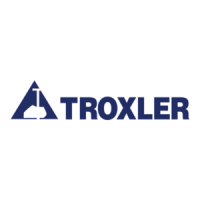T
T
h
h
i
i
n
n
L
L
i
i
f
f
t
t
O
O
v
v
e
e
r
r
l
l
a
a
y
y
s
s
Nuclear gauges, when used in the backscatter mode on overlays
less than 7 cm (3 in.), have certain limitations that must be
overcome in order to obtain correct densities. The problem
arises because the gauge “sees” through the thin overlay and
therefore the underlying material influences the reading.
Recognizing this problem, a nomograph was developed that
allows rapid determination of overlay density. To use the
nomograph, you must know the density of the bottom layer and
the thickness of the top layer.
The simplest method of determining the bottom layer density is
by taking nuclear density tests before the overlay is applied.
Pavement is then placed and compacted.
Backscatter density measurements are made on top of the new
pavement. Knowing the mat thickness, the density of the top
layer may be determined from the nomograph.
NOTE
These procedures and nomographs are applicable
only to the 3401-B and 3411-B gauges. They are not
valid for other Troxler gauges or gauges from other
manufacturers.
Following are examples with nomographs for SI and US
Customary Units.

